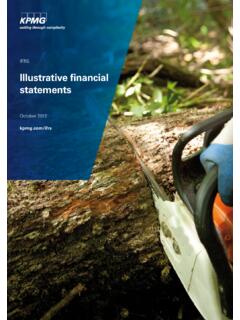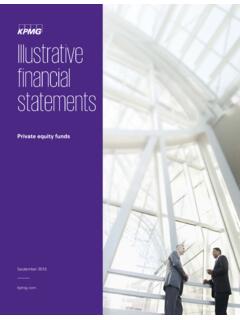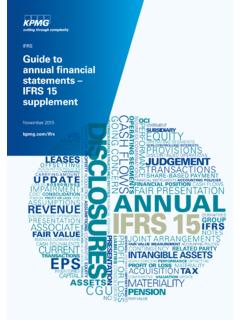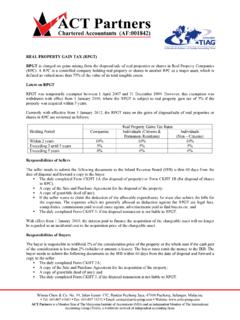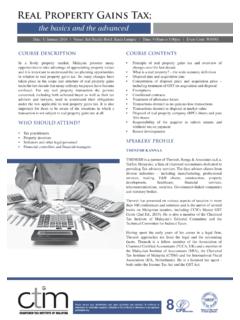Transcription of Taxation of Cross-Border Mergers and Acquisitions
1 KPMG InternatIonal Taxation of Cross-Border Mergers and | Malaysia: Taxation of Cross-Border Mergers and acquisitionsMalaysiaIntroductionMalaysia is a member of the British Commonwealth and its tax system has its roots in the British tax system. the British introduced Taxation to the Federation of Malaya (as Malaysia was then known) in 1947, during the British colonial rule with Income tax ordinance, 1947. the ordinance was repealed with the enactment of the Income tax act, 1967, which came into effect on 1 January 1968, and further tax legislation has since been current principal direct Taxation legislation consists of the following: Income tax act, 1967 (Ita), which provides for the imposition and collection of income tax real property Gains tax act, 1976 (rPGt act), which is imposed on profits from the disposal of real properties in Malaysia and shares in real property companies (rPC) Petroleum (Income tax) act, 1967, which is imposed on profits from petroleum operations Promotion of Investments act, 1986, which provides for tax incentives for persons engaged in promoted industries or activities Stamp act, 1949 (Stamp act), which imposes stamp duty on various instruments.
2 In Malaysia, the Securities Commission is responsible for implementing guidelines for regulating Mergers , Acquisitions and takeovers involving public companies. the regulations formulated for the banking and finance sectors are mainly the responsibility of the Central Bank of Malaysia (Bank negara). Bank negara is also responsible for currency flows to and from the country. For Mergers and Acquisitions (M&a) involving parties undertaking manufacturing activities, the approval of the Ministry of International trade and Industry may be required. Guidance on government policies and procedures can be obtained from the Malaysian Investment Development authority (MIDa) formerly known as the Malaysian Industrial Development authority which is the government s principal agency for the promotion of the manufacturing and services sectors in developmentsMalaysia has gradually reduced its corporate tax rates from 27 percent in year of assessment (Ya) 2007, to 26 percent in Ya 2008, and to 25 percent for Ya 2009 to Ya 2015.
3 The 2014 Budget proposes to reduce the rate to 24 percent from Ya 2016 onwards, in a move to keep Malaysia competitive in the addition, the Malaysian government introduced the following notable changes in its 2014 Budget: implementation of Goods and Services tax from 1 april 2015 increase in rPGt as 1 January 2014; chargeable gains are now taxed at the following rates: 30 percent for disposals within 3 years after acquisition 20 percent for disposals in the 4th year after acquisition 15 percent for disposals in the 5th year after acquisition 5 percent for disposals more than 5 years after acquisition disposals by an individual who is a Malaysian citizen or permanent resident more than 5 years after acquisition are exempt for an individual who is not a Malaysian citizen or permanent resident.
4 A 30 percent rate applies for disposals within 5 years after acquisition and a 5 percent rate applies for disposals more than 5 years after acquisition deadline for applications for tax incentives for new investments in 4 and 5 star hotels in Peninsular Malaysia, Sabah and Sarawak extended to 31 December 2016. 2014 KPMG International Cooperative ( KPMG International ). KPMG International provides no client services and is a Swiss entity with which the independent member firms of the KPMG network are : Taxation of Cross-Border Mergers and Acquisitions | 3 Asset purchase or share purchaseGenerally, in the Malaysian context, M&a transactions are undertaken via the acquisition of shares or a business (such as an asset purchase).
5 Purchase of assetsPurchase priceGenerally, the acquisition price is not deductible (it is a capital cost) except for the cost incurred to acquire qualifying assets in an asset purchase deal (as discussed later in this chapter).GoodwillFor tax purposes, the amount of goodwill written off or amortized to the income statement of the company is non-deductible on the grounds that the expense is capital in Ita contains provisions for granting initial and annual tax-depreciation allowances on qualifying capital expenditure incurred in acquiring or constructing industrial buildings (as defined) and qualifying plant and machinery used for the purposes of the taxpayer s business (subject to certain conditions).
6 The main rates of initial and annual allowances are as follows:Type of allowanceInitial allowanceAnnual allowanceIndustrial building10 percent of qualifying expenditure3 percent of qualifying expenditureHeavy machinery and motor vehicles20 percent of qualifying expenditure20 percent of qualifying expenditurePlant and machinery (general)20 percent of qualifying expenditure14 percent of qualifying expenditureoffice equipment, furniture and fittings and others20 percent of qualifying expenditure10 percent of qualifying expenditureSource: KPMG in Malaysia, 2014In addition to these allowances, the Ita allows (among other things): a tax deduction for capital expenditure on replacement assets that have a life span of 2 years or less and are used for the purposes of the taxpayer s business ( bedding and linen, crockery and glassware, cutlery and cooking utensils, and loose tools) accelerated capital allowance for Information and Communication technology (ICt) equipment (including computers and software), effective from Ya 2009 to Ya 2013 and, under a Budget 2014 proposal, to Ya 2016 a capital allowance equal to the amount of that expenditure is given for small value assets that each cost up to 1,000 Malaysian ringgits (MYr)
7 Where the total capital expenditure of such assets generally does not exceed MYr10,000 (the limit of MYr10,000 does not apply to small and medium enterprises) accelerated capital allowance for security and surveillance equipment (effective from Ya 2008 to Ya 2015). Separate rates apply to certain capital expenditure in, among others, the plantation, mining, forestry, agriculture and hotel allowances or charges may be triggered when a taxpayer disposes of a qualifying capital item (such as industrial buildings and plant and machinery).a balancing allowance arises when the asset s market value or sale price, whichever is higher, is lower than the asset s residual or tax written-down value.
8 A balancing charge arises when the asset s market value or sale price, whichever is higher, exceeds the asset s residual or tax written-down value. However, the amount of balancing charges to be imposed is limited to the amount of capital allowance claimed on the asset prior to its disposal. Capital allowances claimed on qualifying assets that are disposed of within 2 years may be subject to clawback at the discretion of the Inland revenue Board (IrB). this typically applies on the disposal of luxury provisions on balancing allowances, balancing charges and clawbacks are applicable unless the disposal falls within the Ita s controlled transfer provisions.
9 In a controlled transfer situation, the assets are deemed to be transferred at their respective residual values such that no balancing charges or allowances arises. 2014 KPMG International Cooperative ( KPMG International ). KPMG International provides no client services and is a Swiss entity with which the independent member firms of the KPMG network are | Malaysia: Taxation of Cross-Border Mergers and acquisitionsa controlled transfer situation occurs when: the seller of the asset is a person over whom the acquirer of the asset has control the acquirer of the asset is a person over whom the seller of the asset has control some other person has control over the seller and the acquirer of the asset the disposal is effected as a result of a plan of reconstruction or amalgamation of companies the disposal is effected by way of a settlement, gifts or devolution of the property in the asset on death.
10 Tax attributesthe main tax incentives available in Malaysia include pioneer status (an exemption based on statutory income) and investment tax allowance (based on capital expenditure).these incentives are mutually exclusive and limited to promoted activities or form of tax incentive is the reinvestment allowance (ra), which is available to resident companies in the manufacturing and agricultural sectors undertaking expansion,modernization, automation or diversification incentives granted to a company cannot be transferred to the acquirer of assets. thus the acquirer in an asset deal may need to apply to the authorities for new incentives, where added taxCurrently, there is neither a goods and services tax (GSt) nor a valued added tax (Vat) in Malaysia.
